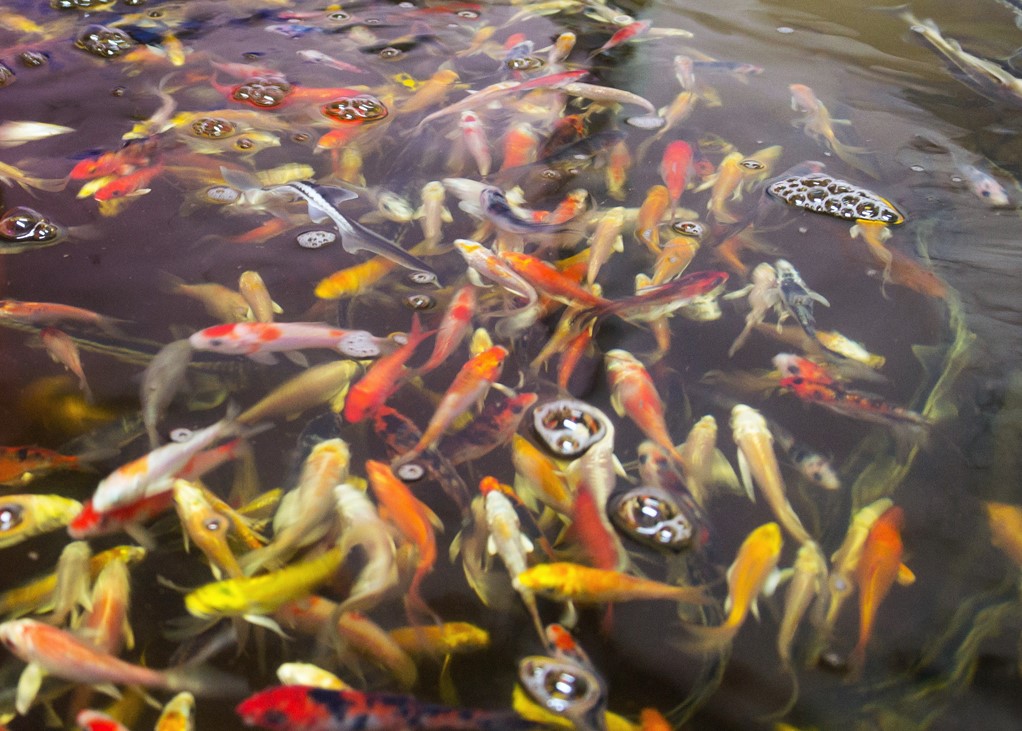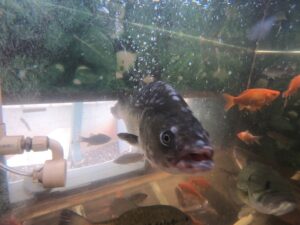After your system is cycled and the biofilter is fully functioning, you are now ready to add fish to your system. The Fin2Food greenhouse system is designed especially for your plants and fish to thrive together, however, there are a few essential factors that you should consider to ensure success for both. Here are the key factors:
Choosing the Best Fish Selection
Choose the best fish species that are suitable for your climate, and location. The most common fish in aquaponics are tilapia, carp, barramundi, jade perch, catfish, trout, cod, salmon, and bass. It is important to know your local fisheries regulation because not all fish are legal to be purchased and grown in some locations.
Acclimating the Fish
To avoid stressing new fish you must acclimatize the fish to the water in your fish tank. To acclimatize the fish, slowly allow the temperature to balance by floating the sealed transportation bags with the fish inside the fish tank. Do this for 15 minutes and add a small amount of water from the tank to the transport water with the fish to slowly acclimate the fish. This should take at least 15 minutes, and you can add the fish to the fish tank.
Fish Feeding
When determining how much to feed your fish, start with a small amount and observe their behavior. If they consume their food quickly, you can increase the amount slightly, but make sure not to overfeed them. If you notice leftover food in the tank after 5 minutes, you may have fed them too much and need to scoop out the remaining food. Adjust the amount of food based on the behavior and appetite of your fish.
Here are some tips for feeding your fish:
Size of food — Your fish food should be adapted to the size and mouth of your fish, smaller fish need smaller food, and bigger fish will eat bigger fish food.
How often to feed your fish – Feed your fish up to two or three times a day.
Do not overfeed — Ensure that the fish are not overfed by feeding them only what they can consume for five minutes, after the five minutes is up remove excess food, as it will affect the water quality.
- How much do fish eat — Fish usually eat 1-2% of their body weight per day. Regularly check the quality of the water.
- Watch fish — Observe your fish behavior while feeding to see if there are changes in the fish behavior, do not feed if they are stressed or sick.
The fish-feed ratio provides a way to balance the components of an aquaponics system. Fish feed rates vary according to the growth stage of the fish.
During the grow-out stages, the recommended fish feeding rate is 1 to 2 percent of their body weight per day. So, if the fish stocking density is 10 to 20 kg per your 300 gallon fish tank, you must provide 200 g of fish feed daily.
During the first two to three months, small fish (like 50 g tilapia fingerling) eat about 3 percent of their body weight daily. So, if you have an initial stocking of 40 fingerlings and weigh 2000 g together, they will consume approximately 60 g of fish feed per day. After two to three months, the feeding rate will be 80 to 100 g of fish feed per day. (It is because the 40 fingerlings will have grown to 80 to 100 g each, and the total weight will be 3200 to 4000 g)
Maintaining Fish Health
It is critical to your aquaponic greenhouse’s function to maintain the health of your fish. Fish are essential to every aquaponics system’s overall welfare and function. So, understanding your fish needs is the most important part of running your greenhouse. Keeping your fish healthy and free from diseases will go a long way toward ensuring that your system is running smoothly. If the fish are unhealthy waste production slows, resulting in poor plant growth and harvest.
Tips on maintaining healthy fish in your aquaponics system:
- Observe fish before and after daily feeding and note how much feed is eaten.
- Observe and take notes of the fish’s behavior and appearance daily.
- Understand the signs of fish stress, disease, and parasites.
- Maintain a low-stress environment with consistent good water quality, specific for the fish in the system.
- Use the proper stocking density and feeding rates.
- Healthy Fish Behavior
Healthy fish in your system shows the following behavior:
- Extended fins and straight tails.
- A graceful pattern of swimming. No lethargy. However, catfish often sleep at the bottom of the fish tank until they wake up and begin feeding.
- A healthy appetite and not shying away at the presence of the feeder.
- No marks, discolored blotches, streaks, or lines.
- Not rubbing or scraping on the sides of the fish tank.
- Sharp, clear, and shiny eyes.




